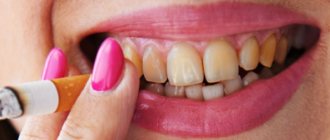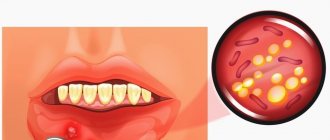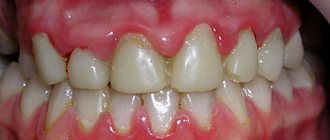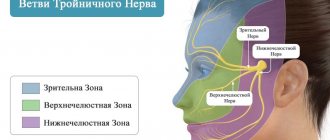In pediatric dentistry, one of the most common reasons for visiting a doctor is black plaque on a child’s baby teeth. It can appear at any age, and sometimes completely unexpectedly: some parents say that the baby went to bed with normal teeth, and woke up with noticeable blackening. Why do young children’s teeth turn black, what should be done in such cases, and how dangerous is this blackening?
What is Priestley's plaque
Plaque on baby teeth of a yellowish, black or brown color appears in a child when bacteria actively multiply in the oral cavity. Priestley's plaque is often seen at an early age, but can also occur in older children. When deposits appear, teeth lose their attractiveness, which can negatively affect the child’s psychological state. If symptoms of this unpleasant phenomenon develop, you should immediately contact your dentist to eliminate Priestley’s plaque in children.
A child has black teeth - what to do?
It is dangerous to ignore this symptom, since the pathology that caused it will develop further. In addition, plaque is a favorable environment for the active proliferation of bacteria, therefore increasing the risk of developing caries.
Diagnostics can take place in several stages. First, the dentist will examine the child's teeth for caries. If caries is excluded, examination using laser equipment and radiography are prescribed. You may need to consult with doctors of other specialties. In cases where no pathology is detected, plaque is simply removed during an ultrasound procedure.
Treatment depends on the cause of the black plaque. If a child is diagnosed with intestinal problems, he is prescribed medications that restore the balance of microflora and his diet is adjusted. If there is a lack of calcium and iron in the body, an appropriate diet is prescribed, including foods containing essential microelements. If caries develops, remineralization or filling is performed. It all depends on the stage of the carious lesion.
Causes of black plaque in children
The main causes of black plaque on teeth are:
- Priestley plaque is the main cause of deposits. Growing up, the child gets rid of this problem, since plaque almost never settles on permanent teeth. This phenomenon does not harm health and is characterized as a purely aesthetic defect.
- Tooth decay is a serious disease that can lead to tooth loss. The carious process is accompanied by yellowing and subsequently blackening of the tooth enamel. When the first symptoms appear, you should immediately consult a dentist.
- Dysbacteriosis is a disease that leads to the appearance of dental plaque due to disturbances in the functioning of the digestive system. The causes of the disease are poor diet, long-term use of medications, chronic diseases affecting the liver or intestines.
- Oversaturation of the body with iron. Prescribing iron-containing medications to children leads to the formation of both black plaque and deposits that are dark purple or brown in color.
In addition, teeth can darken due to a lack of calcium in the body caused by some disease. In general, the exact cause will be revealed during an examination by a dentist.
Other types of plaque depending on color
In addition to black, white or brown plaque may form on a child’s teeth. Green and orange deposits on tooth enamel are also possible. Normally, plaque appears on the teeth of all people; it usually has a light yellow tint. You need to keep this under control, brush your teeth regularly and periodically undergo ultrasonic cleaning - 1-2 times a year. If the plaque takes on any color, you should definitely see a dentist.
White plaque forms on the teeth after every meal. At night, if the oral cavity is not cleaned before bedtime, it continues to grow. Over time, it can harden and turn into tartar, which is a favorable environment for the proliferation of cariogenic microorganisms.
Brown plaque is caused by poor hygiene, overuse of coffee and tea, and smoking. Removing such pigmented plaque at home is problematic. You can use special toothpastes with abrasives, but they have contraindications. To completely get rid of brown plaque, you will have to visit the dentist's office and undergo professional teeth cleaning.
Orange or greenish deposits on the enamel indicate the growth of fungi in the oral cavity. Plaque forms not only on the teeth, but also on the inner surface of the cheeks, gums and tongue. Remove deposits in the dentist's office. Immunoenhancing therapy may also be required to eliminate the fungal infection.
What does ignoring the problem lead to?
Failure to promptly contact a dentist when plaque appears on baby teeth leads to the following negative consequences:
- development of the inflammatory process;
- bleeding gums, which occurs if the child eats or brushes his teeth;
- the likelihood of developing diseases such as caries, stomatitis and periodontal disease increases;
- milk teeth with a black coating are very unaesthetic, which is fraught with the development of complexes in the child;
- deposits may be accompanied by bad breath.
Why do teeth darken?
When a child develops dark plaque, this indicates the proliferation of pathogenic microbes that are deposited on the tooth enamel.
Black deposits may be a sign of:
- thyroid diseases;
- diabetes mellitus;
- helminthiasis;
- dysbacteriosis;
- immunity disorders.
Dark plaque on a child’s tooth enamel appears due to dental pathologies:
- tartar;
- caries;
- mineral deficiency;
- enamel hypoplasia;
- malocclusion.
The cause of tooth discoloration may be the effect of dyes, a disorder in the intrauterine development of the child, or a genetic predisposition.
Preventing the reappearance of black plaque on teeth
Prevention of plaque formation includes:
- Regular dental and oral care. For babies, their gums are cleaned using cotton pads and special silicone tips. When the baby turns two years old, he needs to be taught to properly brush his teeth with a brush and toothpaste, as well as to regularly rinse after meals.
- Balanced diet. Your child's diet should include fewer sugar-laden foods and more natural fruits and a variety of vegetables.
- Timely limitation of the use of pacifiers and bottles. Long-term use of these items leads to the appearance of malocclusion, the development of a certain dependence, and the formation of so-called “bottle caries.” If a child can do without a pacifier and bottle, they should be disposed of.
In addition, you should constantly monitor the state of the child’s immune system and support it with the help of vitamins, which have a beneficial effect on the health of the teeth and the whole body. If you follow these simple recommendations, your child will always delight his parents with his beautiful and healthy smile.
Treatment at the dentist's office
A modern dental clinic offers a wide range of services, including procedures for cleaning teeth from black plaque and their subsequent strengthening. Treatment for dental diseases directly depends on the pathology that provoked the appearance of dark deposits.
Caries treatment is carried out using classical or innovative techniques. All manipulations are performed using anesthesia and do not cause pain to the child.
Diseases such as enamel hypoplasia, tartar and mineral deficiency require mainly preventive procedures, which include oral hygiene and strengthening teeth.
Malocclusion leads to damage to teeth, wear and thinning of enamel and discoloration of teeth. Treatment of bite pathologies involves wearing special orthodontic structures.
Prevention is better than cure
Parents should think about healthy teeth and a snow-white smile for their children from a very early age:
- Start care when the first baby tooth appears. Using dental wipes, a silicone fingertip with a brush, you should brush your baby’s teeth and massage the gums.
- Teach children from the age of 2 to use a brush correctly and brush their teeth twice a day, rinse their mouth after eating.
- Starting from the age of one, you should visit pediatric dentistry with your child twice a year.
- Provide a balanced diet with sufficient vitamins and minerals.
- Wean your child off pacifiers and bottles in a timely manner to form a correct bite.
- Introduce solid foods into your diet to naturally cleanse tooth enamel.
- It is imperative to treat caries of baby teeth.
Such preventive measures and compliance with the rules of oral hygiene will help avoid the appearance of black teeth in a child.
Disease that causes stains on teeth
A dental disease that manifests itself in the form of multi-colored spots on their surface is called hypoplasia . The disease appears during the gestation period of the future dental patient. It develops in a child if the mother, during pregnancy, had stomach problems, and also had a lack of vitamin D or was exposed to a viral disease.
In such cases, it is necessary to increase the child’s immunity and change his diet. First of all, it is necessary to exclude the possibility of excessive amounts of fluoride entering the body. To do this, you should avoid toothpaste with a high content of it. You need to give your child only purified (bottled or filtered) water, and also give him more vitamins, vegetables and fruits.
With the development of the disease, expressed in the appearance of new spots and an increase in the area of existing ones, remineralization is necessary. The procedure consists of the dentist coating the teeth with a special paste containing substances designed to strengthen the enamel. For hypoplasia detected before the age of eighteen, fluoridation or silvering is also performed.
Prevention
All pathologies require preventive manipulations that are aimed directly at removing plaque and strengthening the affected tooth enamel.
Preventive procedures.
- Professional teeth cleaning.
- Remineralization of enamel.
- Fluoridation of teeth.
The dentist consults with parents and the child to teach proper oral hygiene. The specialist also gives recommendations on the choice of dental care products. For general strengthening of the body and dental tissues in particular, a vitamin-mineral complex is prescribed.
Professional teeth cleaning
One of the main methods of eliminating black plaque on teeth is professional enamel cleaning.
At Martinka Dentistry, depending on the age of the patient, professional hygiene is carried out using the following methods.
- Hygienic. (Children under 3 years old). The procedure is performed using professional paste and brush.
- Airflow (from 3 years old). A hardware method for removing plaque using an air stream containing soda crystals.
- Ultrasound (from 16 years old). Cleaning teeth from plaque occurs under the influence of ultrasonic waves.
The advantage of professional teeth cleaning is the achievement of a comprehensive effect. As a result of the procedure, plaque is removed even in hard-to-reach areas, teeth are polished and the enamel is whitened by several tones.
Removing dental plaque at the dentist -
Depending on the amount of plaque and tartar, as well as the equipment of the dental office, the dentist can use the following methods or a combination of them:
- ultrasonic cleaning + conventional mechanical polishing (carried out using a polishing brush and paste),
- ultrasonic cleaning + Air-Flow,
- Air-Flow only.
a) Cleaning dental plaque using Air Flow –
The Air-Flow method is something like sandblasting. From a special tip under high pressure, a water-air mixture with particles of an abrasive-polishing substance is supplied to the tooth surface. This method works great if your layer of pigmented plaque is not too thick and there are no massive hard dental deposits. But if they do exist, then the dentist will first remove the massive deposits with ultrasound and, using Air-flow, polish your teeth, removing all the smallest irregularities and plaque residues.
How to get rid of plaque using Air-flow –
b) Removal of dental plaque using ultrasound –
Ultrasound cleaning of plaque is the most common and most versatile method. Its advantage is that with the help of ultrasonic cleaning devices (scalers) you can remove pigmented plaque of any severity, as well as the most massive hard dental deposits. The cost of the procedure averages from 150 to 200 rubles per 1 tooth, but there are clinics where this service can cost even 400-500 rubles (per 1 tooth).
A nozzle is inserted into the tip of the ultrasonic scaler, the tip of which oscillates at ultrasonic frequency during the procedure, and during the oscillation process water is supplied generously to the tip of the nozzle. As a result of mechanical contact of the nozzle with dental plaque, the attachment of the latter to the tooth is destroyed. The cavitation mechanism also works in parallel. It lies in the fact that the propagation of ultrasonic waves in an aqueous environment leads to the formation of many air bubbles, which burst with the occurrence of hydrodynamic impacts (this leads to cleansing of the tooth surface).
Removing plaque using ultrasound (video) –
After ultrasonic cleaning, tiny particles of plaque (irregularities) always remain on the surface, which must be removed. This can be done either using Air-flow, or using traditional teeth polishing using a rotating polishing brush with bristles and a special polishing paste. If polishing is not done, the tooth surface will remain rough, which will lead to the rapid adhesion of new portions of microbial and pigmented plaque to the teeth.
Prevention of Priestley's plaque
Unfortunately, despite cleaning, this pigmentation may appear again: even professional hygiene does not eliminate the causes of Priestley's plaque. You will have to regularly examine your child’s teeth and have them brushed by the doctor as many times as necessary.
Priestley's pigmentation rate can be slowed down.
For prevention, experts recommend:
- Taking probiotics to control the number of chromatogenic bacteria and iron levels in saliva.
- Eat a proper diet. Avoid excess iron-rich foods in your children's menu. Give preference to dairy products: this increases the number of beneficial bacteria in the mouth and helps maintain a healthy and balanced microflora.
- Remind your child to brush their teeth at least twice a day and use mouthwash. This will help remove the bacteria responsible for Priestley's plaque buildup.
- After each cleaning, rinse your child’s brush well and pour boiling water over it so as not to create an environment favorable for the growth of bacteria.
If you notice black plaque on your child’s teeth, make an appointment at the Smileyk clinic by phone. The pediatric dentist will diagnose the type, help you get rid of it, and check for caries underneath the dark spots.
How can you not be afraid of the dentist from childhood?
Dial-Dent hygienists have extensive experience working with children. At the appointment, hygienists talk about how to properly brush your teeth so that caries is not a problem, and how and why the doctor treats your teeth.
A friendly atmosphere at the reception, children's songs during the procedure, gifts after visiting the doctor - all this builds a positive image of the dentist in the child. That is why, having visited the clinic several times, a six-year-old girl quite calmly goes to see a doctor she knows, knowing that there is absolutely nothing to be afraid of. This is very important because children who do not have fear of the dentist grow into adults who are not afraid to get their teeth treated on time and do not panic at the mere sight of a dental office. Unfortunately, the Dial-Dent clinic is often visited by adult patients who were so frightened by dental treatment in childhood that they can now treat their teeth only under anesthesia.
The cost of professional dental hygiene for a child is 2,740 rubles (professional teeth cleaning for children is 2,090 rubles, strengthening enamel with Tuss Mousse cream is 650 rubles).
See other works of Dial-Dent specialists here.











